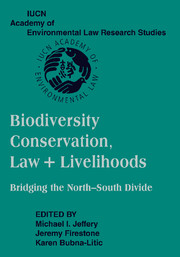 Biodiversity Conservation, Law and Livelihoods: Bridging the North-South Divide
Biodiversity Conservation, Law and Livelihoods: Bridging the North-South Divide Published online by Cambridge University Press: 31 July 2009
LOCATION AND NATURAL CONDITIONS OF THE ECOGRASS PROJECT
The Ecograss Project is in the western part of Jilin province, northeast of China. Geographically, Jilin province is divided into three parts: (1) the mountain-forest area in the east, (2) the plain agricultural lands in the middle, and (3) the grass-desert in the west. Because of climate change effects, including the land becoming drier, as well as overuse of the lands by agriculture and raising domestic animals (the number of which is six times normal capacity), approximately 10,000,000 Mu of western lands are in a state of serious degradation, calcification, and desertification, extending eastward at a rate of 1.4 percent per year, threatening the arable lands in the middle and eastern part of the province as well. Under the policy of sustainable development and rehabilitating the vulnerable agricultural land, the provincial government decided in 2000 that 4,200,000 Mu had to be taken out of agricultural and livestock.
CAUSES AND IMPACTS OF DESERTIFICATION
Desertification has been an obvious result of climate change in the western part of Jilin. Since the 1930s, rainfall has decreased 0.5 millimeters each year on average, and many rivers, lakes, and wetlands have disappeared, as have the birds. The agricultural and grazing lands have greatly dwindled. Sandstorms from the desert have spread to the entire province, to the north part of China, and even across the border and the ocean to Korea, Japan, and Russia.
To save this book to your Kindle, first ensure [email protected] is added to your Approved Personal Document E-mail List under your Personal Document Settings on the Manage Your Content and Devices page of your Amazon account. Then enter the ‘name’ part of your Kindle email address below. Find out more about saving to your Kindle.
Note you can select to save to either the @free.kindle.com or @kindle.com variations. ‘@free.kindle.com’ emails are free but can only be saved to your device when it is connected to wi-fi. ‘@kindle.com’ emails can be delivered even when you are not connected to wi-fi, but note that service fees apply.
Find out more about the Kindle Personal Document Service.
To save content items to your account, please confirm that you agree to abide by our usage policies. If this is the first time you use this feature, you will be asked to authorise Cambridge Core to connect with your account. Find out more about saving content to Dropbox.
To save content items to your account, please confirm that you agree to abide by our usage policies. If this is the first time you use this feature, you will be asked to authorise Cambridge Core to connect with your account. Find out more about saving content to Google Drive.